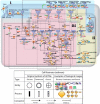The executable pathway to biological networks
- PMID: 20118126
- PMCID: PMC3097101
- DOI: 10.1093/bfgp/elp054
The executable pathway to biological networks
Abstract
As time goes by, it becomes more and more apparent that the puzzles of life involve more and more molecular pieces that fit together in increasingly complex ways. Genomics and Proteomics technologies nowadays, produce reliable and quantitative data that could potentially reveal all the molecular pieces of a particular puzzle. However, this is akin to the opening of Pandora's box; and we are now facing the problem of integrating this vast amount of data with its incredible complexity into some coherent whole. With the aid of engineering methods designed to build and analyze computerized man-made systems, a new emerging field called 'Executable Biology' aims to create computer programmes that put together the pieces in ways that allows capturing their dynamicity and ultimately elucidating how molecular function generates cellular function. This review aspires to highlight the main features characterizing these kinds of executable models and what makes them uniquely qualified to reason about and analyze biological networks.
Figures








References
-
- Fisher J, Henzinger TA. Executable cell biology. Nat Biotechnol. 2007;25:1239–49. - PubMed
-
- Regev A, Silverman W, Shapiro E. Representation and simulation of biochemical processes using the pi-calculus process algebra. Pac Symp Biocomput. 2001;6:459–70. - PubMed
-
- Priami C, Regev A, Shapiro EY, et al. Application of stochastic name-passing calculus to representation and simulation of molecular processes. Inform Proc Lett. 2001;80:25–31.
-
- Regev A, Panina EM, Silverman W, et al. Bioambients: an abstraction for biological compartments. Theoret Comput Sci. 2004;325:141–67.
-
- Kam N, Harel D, Cohen IR. Visual Languages and Formal Methods. IEEE; 2001. The immune system as a reactive system: modeling T cell activation with statecharts; pp. 15–22.
Publication types
MeSH terms
LinkOut - more resources
Full Text Sources
Research Materials

